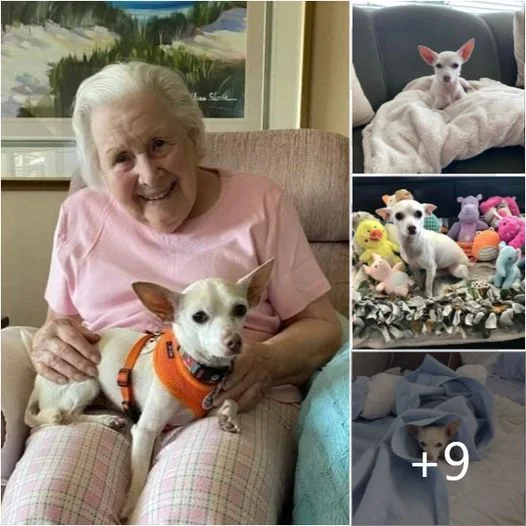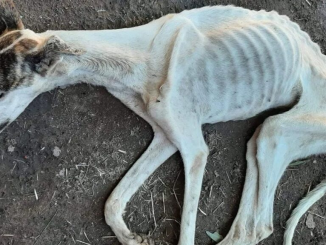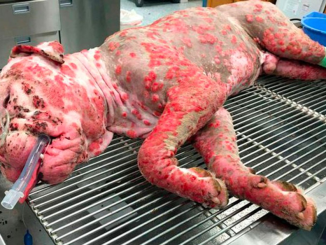
Life has a beautiful way of surprising us, and sometimes, those surprises come in the form of a furry, four-legged companion. Meet Johanna Carrington, a remarkable centenarian who, despite a life filled with challenges, has always carried a deep love for dogs.
Johanna’s journey began in war-torn Germany, where owning a dog was a distant dream. She and her late husband once shared their home with eight Pekingese dogs, a testament to their shared love for these loyal creatures. However, when her beloved dog Rocky passed away, Johanna was left feeling alone in her house, yearning for a furry friend.

One might think that, at the age of 100, adopting another dog could be a challenge. Johanna was uncertain if the shelter would allow someone of her age to adopt. Fortunately, a caring neighbor who supports Muttville Senior Dog Rescue in San Francisco suggested that this organization might have the perfect solution.
Muttville Senior Dog Rescue recognized that Johanna Carrington and a senior dog would be an ideal match. After careful consideration, Johanna adopted Gnocchi, a charming 11-year-old Chihuahua, whom she lovingly renamed Gucci.
Gucci’s life had a rocky start; he was rescued from a hoarding situation where his previous owner had 22 dogs. Being the only pampered pooch in his new home brought him immense joy. Johanna’s caregiver, Eddie Martinez, and her daughter, Debbie Carrington, made a heartfelt commitment to ensure that Gucci’s golden years would be filled with love and care.

The moment Gucci entered his new home, he seemed to recognize that he belonged there. Johanna recalled the heartwarming first encounter, saying, “He approached the home as though he’d been here before. It was incredible. When he spotted me seated in my chair, he leapt up and perched on my lap. He made himself extremely at ease. Right away, he was just our kid.”
Now, Gucci enjoys a life fit for a pampered pup. He has “oodles and oodles” of toys to play fetch with, daily back massages while watching TV with his new mom, and even the privilege of burrowing under the covers in bed for extra comfort.
Debbie Carrington, Johanna’s daughter, shared how Gucci’s arrival transformed their home, saying, “It was sort of sad here after she lost her other dog. It was silent and melancholy until Gucci came in and brought excitement into the house. Laughing at him running around and doing silly things, and then him resting on her lap with her when she’s in her chair or bed, it’s just making her very happy.”
The heartwarming bond between Johanna and Gucci is a testament to the joy and companionship that animals bring into our lives, regardless of age. In fact, scientific research supports the positive impact of pet ownership on emotional and social well-being, particularly in older individuals.

As Johanna approaches her 101st birthday in December, she and Gucci plan to celebrate this special milestone together. For Johanna, dogs have played a significant role in her long and healthy life, proving that the love between a human and their furry friend knows no age limits.
In a world that often seems fast-paced and hectic, the story of Johanna and Gucci reminds us of the simple yet profound happiness that animals can bring into our homes and hearts.
I Found My Daughter Sleeping Under the Stairs—Her Chilling Confession Left Me Shaken
In-laws are supposed to make life easier, right? Well, not in my case. This is the story of how I got back at Linda, who thought she could treat my eldest daughter, Tessa, badly and get away with it.
I have two daughters. Tessa, who is 10, is from my first marriage. She’s sweet, quiet, and always tries to make everyone happy. My younger daughter, Sadie, is 4, from my marriage to Grant, my current husband. Sadie is the opposite—full of energy and always asking questions. Grant loves both girls, but his mother, Linda, feels differently, especially toward Tessa.
Linda is the type of person who wants everything to appear perfect on the outside. But underneath, she’s judgmental and cold, particularly when it comes to Tessa. The reason? Tessa isn’t Grant’s biological daughter.
For years, I tried to keep the peace. Grant would say, “She’s just old-fashioned,” but it was clear Linda’s behavior wasn’t fair to Tessa.

“She’ll come around,” Grant would say. But Linda never did. Instead, she made small, hurtful comments toward Tessa.
Tessa, bless her, never complained. She stayed quiet, probably thinking it was her fault. But I noticed everything. I heard the comments, and each time, it made me angry.
Grant? He didn’t see it the same way. He loved his mom and thought she was just being her usual, quirky self.
I always thought in-laws were supposed to make life easier. But not in my case. This is the story of how I got revenge on Linda, my mother-in-law, who treated my eldest daughter, Tessa, like she didn’t matter.
I have two daughters. Tessa, 10, is from my first marriage. She’s sweet, quiet, and always tries to make people happy. Sadie, 4, is from my marriage to Grant, and she’s full of energy. Grant loves both girls, but his mother, Linda, acts differently, especially toward Tessa.
Linda often made rude comments about Tessa. Sometimes, she’d say things like, “Oh, Tessa, that dress is a bit too grown-up for you, don’t you think?” She would forget Tessa’s birthday but spoil Sadie with gifts.
Things got worse after my own mother passed away. I was crushed by grief, barely able to function. We had to travel out of state for the funeral, and Linda offered to watch the girls. I didn’t want to leave Tessa with her, knowing how uncomfortable she’d be, but I had no other choice.
Three days later, we returned home, and the house was eerily quiet. Linda left a note saying she had taken Sadie to the park, but I couldn’t find Tessa. My heart raced as I searched the house. Then, I saw a light coming from the basement. I went downstairs and found Tessa, curled up on the cold floor, sleeping under a blanket, with dried tears on her face.
“Tessa, why are you down here?” I asked, heartbroken. She told me Linda had made her sleep there, saying Sadie was her “real” granddaughter and they needed “special time” together.
I was furious but knew confronting Linda wouldn’t change things. Instead, I decided to get even. Linda’s family reunion was coming up, and it was her pride and joy. I offered to help her organize it, pretending everything was fine. But behind the scenes, I was telling the family how Tessa was treated, especially during the funeral.
At the reunion, I put together a slideshow of family photos. But in the middle of all the happy pictures, I included a clip of Tessa sleeping on the basement floor. The mood shifted immediately. People were shocked, whispering, “Why would she be down there?”
Linda’s perfect image crumbled as the family questioned her. She tried to explain, but it was too late—everyone saw her for who she truly was. I didn’t need to say anything; the photos said it all.
Since that day, Linda hasn’t spoken to me, and honestly, that’s just fine with me. I’ll always protect my daughter, no matter what.



Leave a Reply